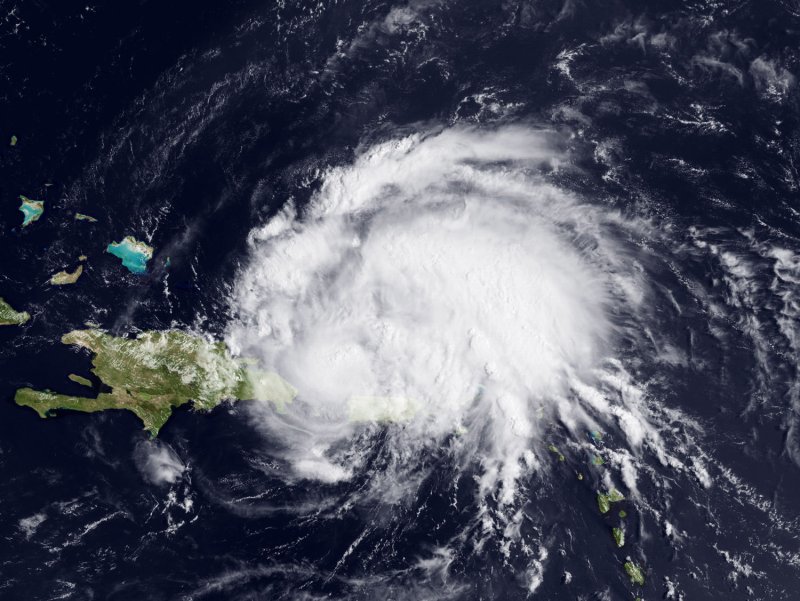This NOAA satellite image shows Hurricane Irene, the first hurricane of the 2011 Atlantic season, as it travels over Puerto Rico on August 21, 2011. Irene, which is traveling on a path for Bahamas and Florida, is expected to strengthen over the next 48 hours, potentially into a Category 2 hurricane. UPI/NOAA |
License Photo
MIAMI, Aug. 24 (UPI) -- Hurricane Irene, pumped up to a Category 3 storm, pounded the Bahamas Wednesday and gathered strength as it headed toward the U.S. East Coast, forecasters said.
The National Hurricane Center in Miami said Irene was "hitting the southeastern Bahamas hard." In its 8 p.m. EDT update, the center said the storm, with sustained top winds of 120 mph and higher gusts, was moving between Rum Cay and Long Island, Bahamas, and heading northwest at 12 mph.
The storm was expected to continue in that general motion Wednesday night and then turn toward the north-northwest before turning north Thursday and Thursday night. On its forecast track, Irene will cross the central Bahamas Wednesday night and northwest Bahamas Thursday.
The storm should gain strength during the next day or two and could become a Category 4 hurricane by Thursday, forecasters said.
A hurricane warning was posted for the southeastern, central and northwestern Bahamas. A tropical storm warning for the Turks and Caicos Islands has been discontinued.
United Nations officials in New York said Irene's heavy rains were causing flooding and agricultural damage in Haiti, a Caribbean island nation always vulnerable to storms because it lacks a tree canopy. U.N. officials said more than 160 evacuation sites had been opened and aid supplies have been mobilized in anticipation that Haitians will be displaced. However, no major losses or damage had been reported.
Haiti is still recovering from a 2010 earthquake and last November's Hurricane Tomas.
Forecasters said Irene was expected to shift gradually toward the northwest through Wednesday night and then veer northward Thursday.
Irene could produce 6-12 inches of rain in the Bahamas and the Turks and Caicos Islands, the center said. The storm also could produce 1-3 inches of additional rain across Puerto Rico and Hispaniola, with isolated storm amounts of 15 inches possible, the center said. The rains could produce life-threatening flash floods and mudslides in areas of steep terrain.
Hurricane- or tropical storm-force winds and storm surges also were forecast in the warning area.
In the Bahamas, the storm surge could hit 11 feet, posing a more deadly threat than hurricane-force winds and drenching rain, The Miami Herald reported.
"It's always a big concern," said Geoffrey Greene, senior meteorologist with the Bahamas Department of Meteorology. "We are a flat island nation. We know we're going to get some flooding."
Whether Irene would make landfall in the United States was uncertain, forecasters said. The hurricane center reported "high confidence" in a scenario in which Irene's core would be about 200 miles off the Florida coast for the next few days, the Herald said. After that, the track was uncertain, with computer models indicating an eastward path that stretched from South Carolina to New England.
In a joint conference, hurricane center chief Bill Read and Craig Fugate, director of the Federal Emergency Management Agency, said the storm could hit anywhere in the target zone or hit the mid-Atlantic coast, or possibly trigger severe flooding in New England.
"The impact could be widespread, depending on exactly where the storm goes," Read said. "We see no reason for it not to be a major hurricane."
Fugate said Irene's projected path was so close to the coast that communities must "be on a hair-trigger" when it comes to evacuations.
Irene has so far left some damage in its wake but no reported deaths.
U.S. President Barack Obama, at the Puerto Rican governor's request, issued a disaster declaration for the island, which sustained power outages affecting nearly 1 million people and widespread flooding.
In the Dominican Republic, officials reported flooding, downed trees and snapped power lines. It also hit oceanfront communities in the west and north, damaging homes and forcing 12,500 people to evacuate. An estimated 200,000 were without power.















